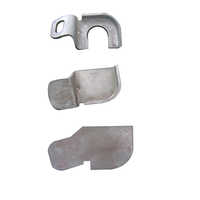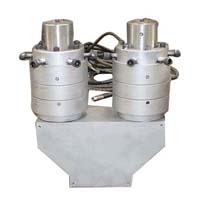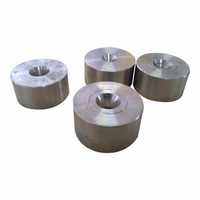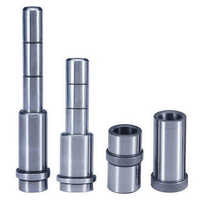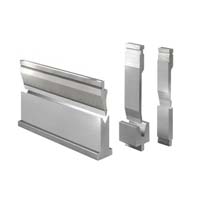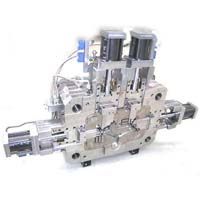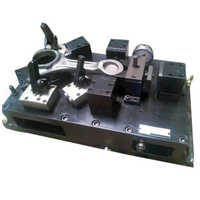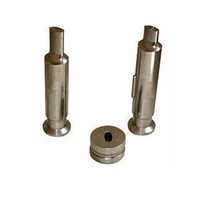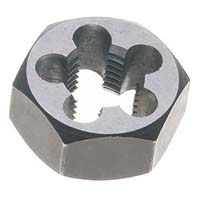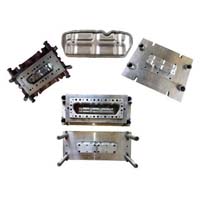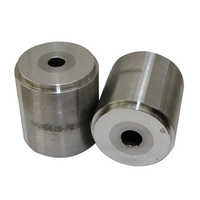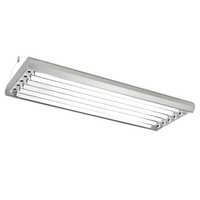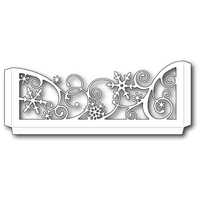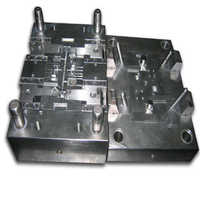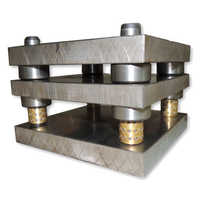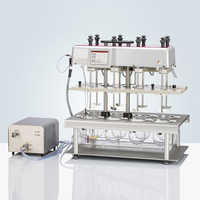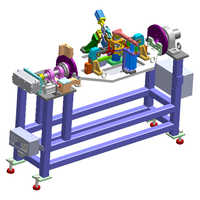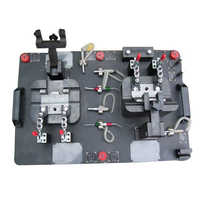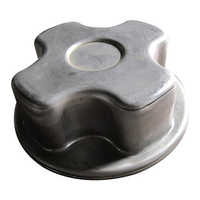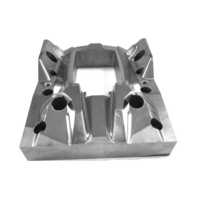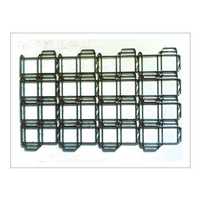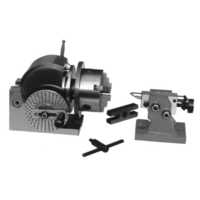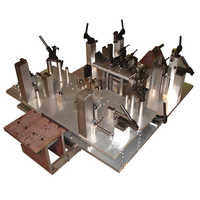Dies,Jigs,Fixtures
(4614 products)
Access a comprehensive database of global and Indian manufacturers, exporters & suppliers of Dies, Jigs, Fixtures. View product & contact details of listed Dies, Jigs, Fixtures sellers with ease, select the companies and send them your requirements directly.
Related Categories
Abrasives
Acoustic Products
Acrylic Sheets
Air Blowers
Air Compressors & Air Separation Plants
Air Cooler
Air Dryers
Air Receiver
Air Valves
Aluminum Castings
Anchors
Anti Vibration Mounts
Ball & Roller Bearings
Ball Valves
Ballast Making Machines
Bearing Parts & Components
Bearings
Bellows & Expansion Joints
Belt Pulleys
Boilers, Components & Spares
Bolts
Bright Bars
Bristles
Burners/Industrial Burners & Incinerators
Bushings & Bushing Parts
Butterfly Valves
CNC Machined Components
Cable Pulleys
Capital Goods
Carbon & Graphite Products
Castor Wheels
Centrifugal Pumps
Centrifuges
Ceramics
Chains & Chain Link Fence Fittings
Cleaning Equipment
Clips, Clamps
Coils
Combustion Equipment
Compression Springs
Compressors & Allied Equipment
Control Valves
Conveyor & Conveyor/Industrial Belts
Cooling Tower & Chilling Plants
Coupling
Cranes
Cryogenic Equipment
Cutting Tools, Broaches & Cutters
Departmental Shelving
Diaphragm Valves
Die Castings
Dies & Moulds
Dies,Jigs,Fixtures
Diesel Engine & Electric Locomotive Spares
Draught Fan
EOT Cranes
Electric Hoists
Electric Motors & Engines
Electroplating Chemicals & Equipment
Energy Management System
Engine Valves
Engineering Goods & Equipment
Engineering Plastics
Engraving Equipment
Extruded Profiles
Fasteners
Fiberglass Products
Filter Cartridges & Media
Filter Cloth, Filter Industrial
Filters-Air, Gas, Liquid
Filtration & Sedimentation Units
Flat Metal Processing Equipment
Float Valves
Fork Lift Truck Parts
Fork Lift Trucks
Forklifts
Foundry Raw Material & Equipment
Furnace Manufacturers
Galvanized Fasteners
Gantry Cranes
Gaskets
Gate Valves
Gauges & Gauge Glasses
Gear Boxes, Reduction Gears & Gear Cutting
Girder Cranes
Glass & Glass Products
Glass Cutting Tools/Glass Cutters
Globe Valves
Goliath Cranes
Grating
Hand & Allied Tools
Hand Pump
Hardware & Tools
Heat Exchangers
Heating Elements
Hex Bolts
Hex Nuts
Hooks & Mounts
Hoses
Hot Air Oven
Humidification & Ventilation Equipment
Hydraulic Hoses & Flexible Metal
Hydraulic Press
Hydraulic Press Brakes
Hydraulic Products & Equipment
Hydraulic Valves
Induction Heating Equipment
Industrial Automation
Industrial Brakes
Industrial Brushes
Industrial Clothing
Industrial Clutches
Industrial Cylinders
Industrial Dryers
Industrial Evaporators
Industrial Knives
Industrial Nets
Industrial Ovens
Industrial Rollers
Industrial Supplies Stocks
Industrial Supplies-General
Industrial Tape
Industrial Tools
Industrial Valves
Industrial Vibrator
Inspection Equipment
Instrumentation
Internal Combustion Engine
Jib Cranes
Laboratory Furniture
Laboratory Glassware & Equipment
Laundry Equipment
Lined Valves
Machine Tools Accessories
Marking Systems
Material Handling Equipment
Measuring Tools & Equipment
Mechanical Seals
Metallised Capacitor Films
Mining Equipment
Mining, Exploration & Drilling Machinery
Model Making Materials
Motor Couplings
Moulded Components
Moulds
Needle Valves
Needles
Nuts
Oil Seals
Outdoor Cooling Systems
Overhead Cranes
PVC Hoses
PVC Products
Paint Brushes
Painting Equipments & Maintenance
Perforated Sheets
Plastic Processing Machinery Parts
Plastic Valves
Plastic Welding Equipment
Plate Valves
Plug Valves
Pneumatic Products & Tools
Pneumatic Valves
Polish & Polishing Material/Machinery
Power Press
Precision Brass Components
Pressed Components
Pressure Gauges
Pressure Vessels
Pulleys
Pulverizers
Pump Spares Parts
Pumps & Pumping Equipment
Radiators
Refrigeration & Equipment
Rope Pulleys
Rope,Twines & Webbings
Ropes
Rotary Valves
Rubber & Rubber Products
Rubber Gaskets
Rubber Roller
Rubber Seals
Rubber Transmission Belts
Screws
Seals
Sensors & Transducers
Shaft Couplings
Shafts & Shaft Collars
Sheet Metal Components & Parts
Solenoid Valves
Springs
Stainless Steel Bolts
Stainless Steel Fasteners
Stainless Steel Nuts
Stainless Steel Valves
Storage Systems
Storage Tanks
Submersible Pumps
Surface Finishing Equipment
Synthetic Industrial Diamonds
Thermostatic Bimetals & Thermostats
Trolleys & Carts
Tungsten Carbide
Ultrasonic Equipment
V-Belts
Vacuum Equipment & System
Valves
Valves Fittings
Vibrating Screen
Washers
Water Coolers
Weighbridge
Welding & Soldering Supplies
Welding Electrodes
Welding Equipment
Winches
Wire Drawing Dies
Wire Rope Hoists
Wire Ropes
Explore More Categories
PCB Separating Routing Machine
Price: 60000 INR (Approx.)/Unit
MOQ - 1 Unit/Units
24 Years
Response Rate: 91.38%
Business Type: Manufacturer | Exporter
ESTOVIR TECHNOLOGIES
Stainless Steel Pillar Die Set Application: Industrial
Die Head - Pillar Die Set
Usage - Industrial
Height - 2-4 Inch (in)
6 Years
Business Type: Manufacturer | Distributor
VE TO CLAMPING SYSTEMS PRIVATE LIMITED
Pvc Pipe Twin Die Head, Usage/Application: Industrial
6 Years
Business Type: Manufacturer | Distributor
VITAL FORCE ENGINEERING
Job Holding Fixtures 6 8 Inch Flat Component
Price: 7000.00 - 9000.00 INR (Approx.)/Set
MOQ - 50 Set/Sets
4 Years
Business Type: Manufacturer
PLUS ONE AUTOMATIONS
Indian Inquiries Only
Cnc Press Brake Bending Machine Punch And Die Press Application: Industrial
MOQ - 1 Unit/Units
Warranty - Yes
Product Type - Press Brake Die
Material - Metal
3 Years
Business Type: Manufacturer | Distributor
NANJING PRIMA CNC MACHINERY CO., LTD.
Biw Welding fixtures
Price: 450000 INR (Approx.)/Number
MOQ - 20 Number
Business Type: Manufacturer | Supplier
JP ROBOTICS & AUTOMATION LLP
Silver Plastic Dies
Price: 5000.00 - 10000.00 INR (Approx.)/Piece
MOQ - 1000 Piece/Pieces
Product Type - Plastic Dies
Usage - Industrial
Color - Silver
17 Years
Business Type: Manufacturer | Distributor
DRISHTI POLYMERS
Pu Foam Moulding Fixture Application: Industrial
Price: 100000.00 - 500000.00 INR (Approx.)/Unit
MOQ - 1 Unit/Units
Size - Standard
Product Type - Moulding Fixture
Warranty - 1 Year
19 Years
Business Type: Manufacturer | Exporter
HYDRO POWER ENGINEERING SYSTEM
Indian Inquiries Only
Steel Die Punches Usage: Automobile Industry
Price: 50 INR (Approx.)/Piece
Usage - Automobile Industry
Product Type - Die Punches
Material - Other
8 Years
Business Type: Manufacturer | Trading Company
GENAUE GROUP
Brown Forming Mould
Price: 10.00 - 60.00 INR (Approx.)/Piece
MOQ - 100 Piece/Pieces
Working Process - Other
Product Type - Mould
Color - brown
9 Years
Business Type: Manufacturer
ACUTE LASER DIE INDIA LLP
Indian Inquiries Only
Jig and Fixture For Drilling
Price: 12300 INR (Approx.)/Number
MOQ - 1 Number
8 Years
Business Type: Manufacturer
JYOTI HYDRAULIC
Easy To Use Pasta Shape Pasta Dies
Product Type - Pasta Shape Pasta Dies
Color - Grey
Material - Steel
13 Years
Business Type: Manufacturer | Distributor
BID
Wrinkle Paper Plate Die Hardness: Hard
Price: 10000 INR (Approx.)/Unit
MOQ - 10 Unit/Units
Working Process - Bending
Usage - Industrial
Material - Steel
2 Years
Business Type: Manufacturer | Distributor
VISHWAKARMA MACHINERY
Indian Inquiries Only
White Panipuri Die
Price: 40000.00 - 70000.00 INR (Approx.)/Piece
MOQ - 1 Piece/Pieces
Product Type - Dies
Usage - Automatic/Manual
Weight - 50 Grams (g)
3 Years
Business Type: Manufacturer | Exporter
KGN INDUSTRY
Brown Industrial Scrubber Packing Die
Price: 1800 INR (Approx.)/Piece
MOQ - 100 Piece/Pieces
Warranty - No
Usage - Commercial
Size - customized
1 Years
Business Type: Manufacturer | Supplier
Bapasitaram Enterprise
Tin Can Die Hardness: Hard
Price: 80000 INR (Approx.)/Unit
MOQ - 10 Unit/Units
Usage - Industrial
Material - Steel
Hardness - Hard
3 Years
Business Type: Manufacturer
J V MACHINE TOOLS PRIVATE LIMITED
Automotive Stamping Dies
Price: 210000.00 INR (Approx.)/Piece
MOQ - 1 Piece/Pieces
Material - iron
Product Type - Automotive Stamping Dies
Weight - 45 Kilograms (kg)
6 Years
Business Type: Manufacturer | Exporter
Bhawani Industries Private Limited
Deep Drawing Dies
Price: 2000000-60000000 INR (Approx.)/Piece
MOQ - 1 Piece/Pieces
12 Years
Business Type: Manufacturer | Exporter
SHARMA PRESSES
Highly Durable Perforation Die
Price: 25000 INR (Approx.)/Set
MOQ - 1 Set/Sets
Material - Carbon Steel
13 Years
Business Type: Manufacturer | Exporter
SWASTIK ENGINEERING CORPORATION
Customized Tungsten Carbide Nibs Drawing Dies Hardness: Hard
MOQ - 50 Piece/Pieces
Usage - Industrial
Size - As per req.
Warranty - Yes
1 Years
Business Type: Manufacturer | Distributor
Hebei Success Technology Co Ltd
Dies,Jigs,Fixtures Manufacturers | Suppliers in India
| Company Name | Location | Member Since |
|---|---|---|
| Estovir Technologies | Gurugram, India | 24 Years |
| Hydro Power Engineering System | Bengaluru, India | 19 Years |
| Drishti Polymers | Ahmedabad, India | 17 Years |
| Jendamark India Private Limited | Pune, India | 15 Years |
| Bid | Dnipro, Ukraine | 13 Years |
| Swastik Engineering Corporation | Rewari, India | 13 Years |
| Sharma Presses | Gurugram, India | 12 Years |
| National Trading Company | Bhiwandi, India | 9 Years |
| Acute Laser Die India Llp | New Delhi, India | 9 Years |
| Genaue Group | Faridabad, India | 8 Years |
Dies and moulds: Types & Applications
Compression molds, injection molds, transfer molds, and blow molds are all examples of basic mold types used in plastic processing, and they are typically categorized according to the number of cavities they include.
Die Types:
1. Simple Die
One operation every press slide stroke characterizes a simple die, also called a single-operation die. This die style is more commonly employed for less substantial tasks in the business world. Producing lightweight metal components is one such application.
2. Compound Die
With a compound die, you can accomplish more than one thing at once, such cutting or punching. For more complicated blanking and piercing tasks, a compound die can complete the work more quickly. Instead of performing each step individually, the compound die may blank and pierce in one fell swoop. For mass-produced items, this is the best option.
3. Combination Die
The combination die is functionally and aesthetically identical to the compound die. It's multitasking abilities mean it can process multiple requests simultaneously, so you get more accurate and timely responses. The combination die has additional utility as a cutting and shaping tool.
Mold Types:
1. Single –Cavity Mold
One of the most fundamental mold concepts is this mold. Only one part at a time can be molded using this mold.
2. Dedicated Multiple Cavity Mold
In order to mass-produce an item, factories will use specialised molds with several cavities. Because it is simple to regulate the plastic flow using this mold, it has found widespread use.
3. Family Mold
Due to the short molding times, prototype molds benefit greatly from family cavity molds. Multiple cavities in a family injection mold allow for the simultaneous creation of several identical products within a single molding run.
4. Two-Plate Mold
When creating plastic components, a two-plate mold is employed. This sort of molding is extremely frequent because of how simple it is to execute.
5. Three-Plate Mold
In three-plate molds, the runner is housed in the third plate, known as the striper. A double-action ejector mechanism ensures that the runner is not thrown out along with the component.
Dies And Moulds Meaning
Tools for making precise shapes include dies and molds. Sheet metal and other metal shapes can be shaped with dies. The automotive industry is a prime example of this type of use. In contrast, injection molding employs molds for the creation of plastic parts from liquid resin or metal castings from molten metal
In modern manufacturing, molds and dies are indispensable instruments for mass production. Molds are used in injection molding to form resin and in casting, while dies are used in stamping; both play critical roles in the production process.
Modern methods allow for the creation of molds and dies with micron-order precision, facilitating the mass manufacture of products with consistent form and quality across many industries.
Mould And Die Design
1. Stacked mold Design
The cavities in a stacked injection Dies & Moulds are arranged in rows and columns. This allows several cavities to be set up in a single device. By stacking four single cavities in an injection machine, for instance, four identical parts can be manufactured in a single cycle.
As a result, the efficiency of the machine is increased. Injection molds are further classified as either Hot runner molds or Cold runner molds based on the feeding system.
2. Hot Runner mold design
It is common practice for a hot runner mold system to include hot nozzles, temperature control boxes, manifolds, and accessories. An integral part of hot runner molds is the runner system, which is heated in advance by means of rods, coils, or heating components. In a three-plate mold, the runner system is contained within a stationary plate.
Even if the part cools down, the runner system will keep it at a safe temperature. A runnerless mold is one in which the runner does not release the portion. There won't be a need to go through an extra step to get rid of the runner.
Due of the necessity for a heating system to heat the runner, hot runner molds tend to be more costly. It also increases the price of the mold by adding an extra plate. It's also difficult to clean the runner system because the runners are hard to access due to being embedded in the mold.
Hot runner molds are more difficult to run and keep in good condition than cold runner molds. Changing the material of the part requires extensive labor on the part of the mold.
3. Transfer Die Design
Several tools can be operated with just one press using the transfer die. Using transfer dies has certain benefits, especially in mass production. To finish shaping a metal workpiece, it can freely transfer the work by adding shape.
In the past, each step of these procedures was completed by hand, with the workpiece being transferred manually between separate presses and dies. Single-press efficiency is greatly improved by automating the transfer process.
4. Progressive Die Design
A progressive die can do numerous operations at once, but it does so in stages at different machines. The progressive die is superior because of the increased productivity that comes from working quickly while using less force.
The progressive die makes it simpler to achieve peak punching efficiency in a multi-station layout, despite the fact that its management is more complex than that of a single-station device.
To mass produce complex components like those used in automobiles and electronics, engineers employ progressive dies.
Difference Between Mould And Die
Die
- A die is a specialized piece of machinery utilized in the industrial sector for cutting and/or forming materials into the desired form. A die is used to shape only two of a part's three dimensions, as opposed to a mold, which shapes the item from start to finish. Other process variables determine the third dimension, which is typically thickness or length.
- Tool steel, a special type of carbon steel and alloy steel, is commonly used in the production of dies and other types of tooling such as cutting tools and hand tools.
- High strength, wear resistance, plus impact toughness at both room temperature and higher temperatures are the hallmarks of tool steels' unique alloy composition. Dies are helpful because of the volume of material they can cut.
Mold
- A mold is a tool used in manufacturing that is designed to create objects of a specific design and dimensions. Materials can be shaped into components or finished goods by applying pressure using specialized tools that are mounted on the press as part of the manufacturing process.
- A mold is used to create a complete three-dimensional plastic item during plastic manufacturing. Metal-plastic forming molds, mold injection molds and Casting molds are just a few examples of the many categories of molds, but their common purpose is obvious.
- Blow molding, reaction injection molding, thermoforming, and Injection molding, are all mold-based plastics processing techniques.
Die And Mold Industry
1. Overview
From 2020 to 2025, the Indian dies and molds market is forecast to expand by USD 1.47 billion, representing a compound annual growth rate (CAGR) of 9%.
2. Trends and Challenges
As far as we can tell, the expansion of the market before, during, and after the COVID-19 era was unaffected. Growth in the dies and molds market in India is being propelled by new possibilities in aluminum metal injection molding, but the market could be stymied by issues including a shortage of competent workers in the industrial sector.
The researchers have analyzed past data to identify the leading market drivers and the consequences of the COVID-19 pandemic for India's dies and molds sector. In order to deduce objectives and fine-tune advertising campaigns to get an advantage over the competition, a comprehensive analysis of the drivers is required.
3. Key Players
- Godrej & Boyce Manufacturing Co. Ltd.
- Alfa Plast Mould, Classic Die Tools
- Hindustan Die Castings
- Sankalp Engineering & Services Pvt. Ltd.
- NAGATA AUTO PARTS Co. Ltd.
- JPM Group
- DIETECH INDIA (P) Ltd.
Conclusion
Plastics, resin, and metal casting are common uses for molds. A die is a tool used for cutting and shaping metal into a specific profile. Commonly, the same alloys were used for both dies and molds. However, a durable mold manufactured from high-strength metals isn't always necessary, especially for smaller applications. After that, we may switch to using materials like plastic, silicone, and wood to create molds.
FAQs: Dies and moulds
Q. What are the top Die And Mould Manufacturers in India?
Ans. Here are the top manufactures:
- Godrej & Boyce Manufacturing Co. Ltd.
- Hindustan Die Castings
- Sankalp Engineering & Services
- Greatoo Intelligent Equipment Inc.
Q. Types of Moulds And Dies.
Ans. Here are some basic types:
- Simple Die
- Compound Die
- Transfer Die
- Single Cavity Mold
- Dedicated Multiple Cavity Mold
- Two plate mold
- Three Plate mold
- Cold Runner mold
Q. How to start Dies and Mould in India.
Ans. Here are the steps:
- Find a niche and focus
- Plant Layout
- Warehousing for injection molding
- Required molding machine
- Select the equipment
Q. Applications of Dies and Mould
Ans. Die cutters and molds serve the same function in the manufacturing industry. Metal sheet and other shapes can be formed using dies. Fabricating car bodies is a common use case. Conversely, injection molding, which can be done with molten resin or metal, requires the usage of molds.
Related Categories
Related Categories
Abrasives
Acoustic Products
Acrylic Sheets
Air Blowers
Air Compressors & Air Separation Plants
Air Cooler
Air Dryers
Air Receiver
Air Valves
Aluminum Castings
Anchors
Anti Vibration Mounts
Ball & Roller Bearings
Ball Valves
Ballast Making Machines
Bearing Parts & Components
Bearings
Bellows & Expansion Joints
Belt Pulleys
Boilers, Components & Spares
Bolts
Bright Bars
Bristles
Burners/Industrial Burners & Incinerators
Bushings & Bushing Parts
Butterfly Valves
CNC Machined Components
Cable Pulleys
Capital Goods
Carbon & Graphite Products
Castor Wheels
Centrifugal Pumps
Centrifuges
Ceramics
Chains & Chain Link Fence Fittings
Cleaning Equipment
Clips, Clamps
Coils
Combustion Equipment
Compression Springs
Compressors & Allied Equipment
Control Valves
Conveyor & Conveyor/Industrial Belts
Cooling Tower & Chilling Plants
Coupling
Cranes
Cryogenic Equipment
Cutting Tools, Broaches & Cutters
Departmental Shelving
Diaphragm Valves
Die Castings
Dies & Moulds
Dies,Jigs,Fixtures
Diesel Engine & Electric Locomotive Spares
Draught Fan
EOT Cranes
Electric Hoists
Electric Motors & Engines
Electroplating Chemicals & Equipment
Energy Management System
Engine Valves
Engineering Goods & Equipment
Engineering Plastics
Engraving Equipment
Extruded Profiles
Fasteners
Fiberglass Products
Filter Cartridges & Media
Filter Cloth, Filter Industrial
Filters-Air, Gas, Liquid
Filtration & Sedimentation Units
Flat Metal Processing Equipment
Float Valves
Fork Lift Truck Parts
Fork Lift Trucks
Forklifts
Foundry Raw Material & Equipment
Furnace Manufacturers
Galvanized Fasteners
Gantry Cranes
Gaskets
Gate Valves
Gauges & Gauge Glasses
Gear Boxes, Reduction Gears & Gear Cutting
Girder Cranes
Glass & Glass Products
Glass Cutting Tools/Glass Cutters
Globe Valves
Goliath Cranes
Grating
Hand & Allied Tools
Hand Pump
Hardware & Tools
Heat Exchangers
Heating Elements
Hex Bolts
Hex Nuts
Hooks & Mounts
Hoses
Hot Air Oven
Humidification & Ventilation Equipment
Hydraulic Hoses & Flexible Metal
Hydraulic Press
Hydraulic Press Brakes
Hydraulic Products & Equipment
Hydraulic Valves
Induction Heating Equipment
Industrial Automation
Industrial Brakes
Industrial Brushes
Industrial Clothing
Industrial Clutches
Industrial Cylinders
Industrial Dryers
Industrial Evaporators
Industrial Knives
Industrial Nets
Industrial Ovens
Industrial Rollers
Industrial Supplies Stocks
Industrial Supplies-General
Industrial Tape
Industrial Tools
Industrial Valves
Industrial Vibrator
Inspection Equipment
Instrumentation
Internal Combustion Engine
Jib Cranes
Laboratory Furniture
Laboratory Glassware & Equipment
Laundry Equipment
Lined Valves
Machine Tools Accessories
Marking Systems
Material Handling Equipment
Measuring Tools & Equipment
Mechanical Seals
Metallised Capacitor Films
Mining Equipment
Mining, Exploration & Drilling Machinery
Model Making Materials
Motor Couplings
Moulded Components
Moulds
Needle Valves
Needles
Nuts
Oil Seals
Outdoor Cooling Systems
Overhead Cranes
PVC Hoses
PVC Products
Paint Brushes
Painting Equipments & Maintenance
Perforated Sheets
Plastic Processing Machinery Parts
Plastic Valves
Plastic Welding Equipment
Plate Valves
Plug Valves
Pneumatic Products & Tools
Pneumatic Valves
Polish & Polishing Material/Machinery
Power Press
Precision Brass Components
Pressed Components
Pressure Gauges
Pressure Vessels
Pulleys
Pulverizers
Pump Spares Parts
Pumps & Pumping Equipment
Radiators
Refrigeration & Equipment
Rope Pulleys
Rope,Twines & Webbings
Ropes
Rotary Valves
Rubber & Rubber Products
Rubber Gaskets
Rubber Roller
Rubber Seals
Rubber Transmission Belts
Screws
Seals
Sensors & Transducers
Shaft Couplings
Shafts & Shaft Collars
Sheet Metal Components & Parts
Solenoid Valves
Springs
Stainless Steel Bolts
Stainless Steel Fasteners
Stainless Steel Nuts
Stainless Steel Valves
Storage Systems
Storage Tanks
Submersible Pumps
Surface Finishing Equipment
Synthetic Industrial Diamonds
Thermostatic Bimetals & Thermostats
Trolleys & Carts
Tungsten Carbide
Ultrasonic Equipment
V-Belts
Vacuum Equipment & System
Valves
Valves Fittings
Vibrating Screen
Washers
Water Coolers
Weighbridge
Welding & Soldering Supplies
Welding Electrodes
Welding Equipment
Winches
Wire Drawing Dies
Wire Rope Hoists
Wire Ropes
